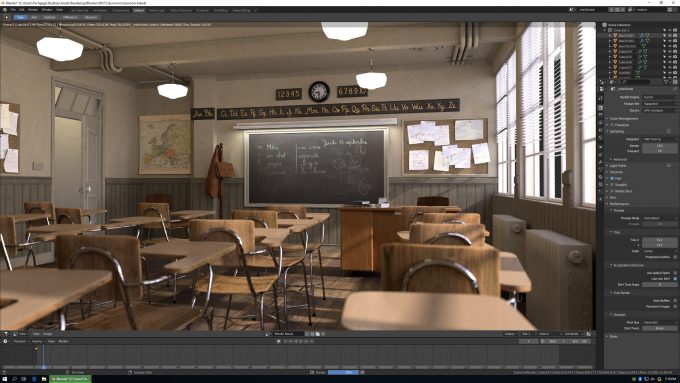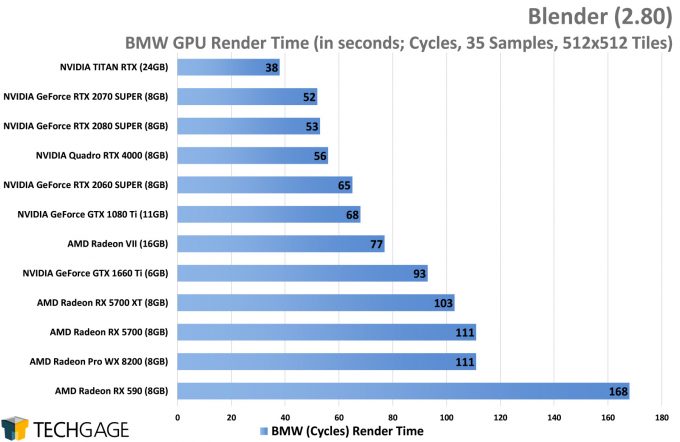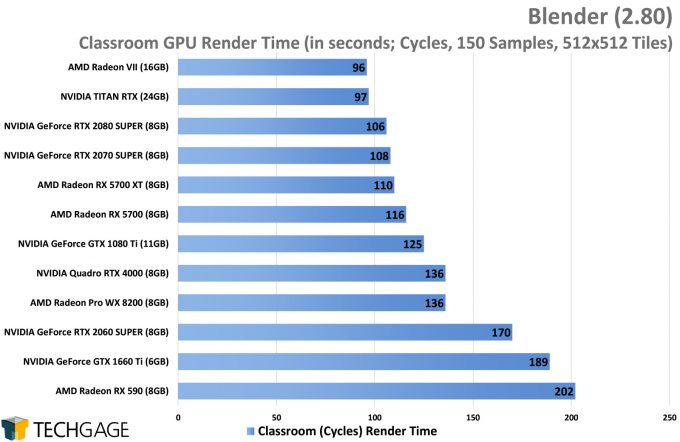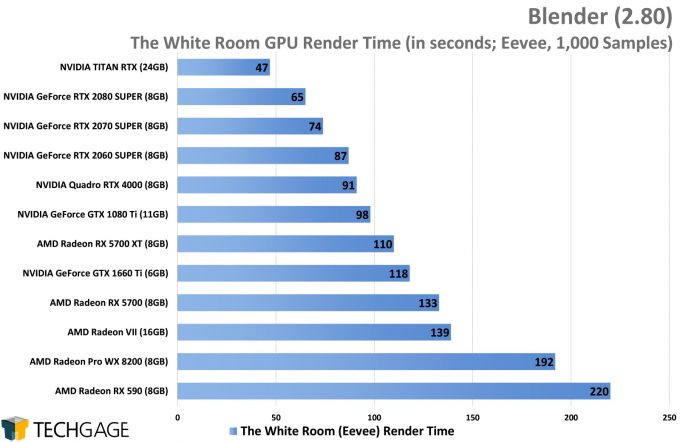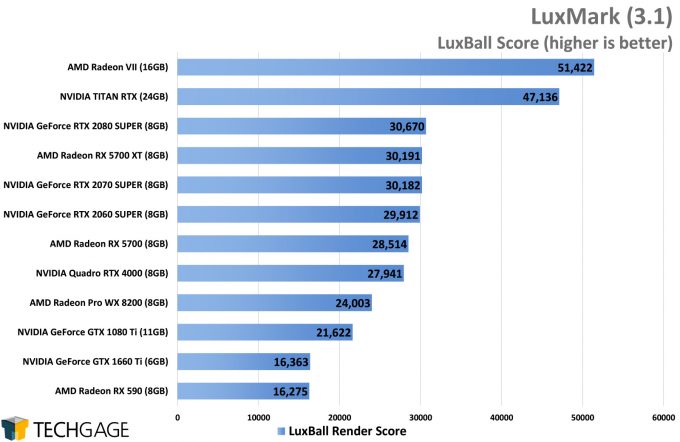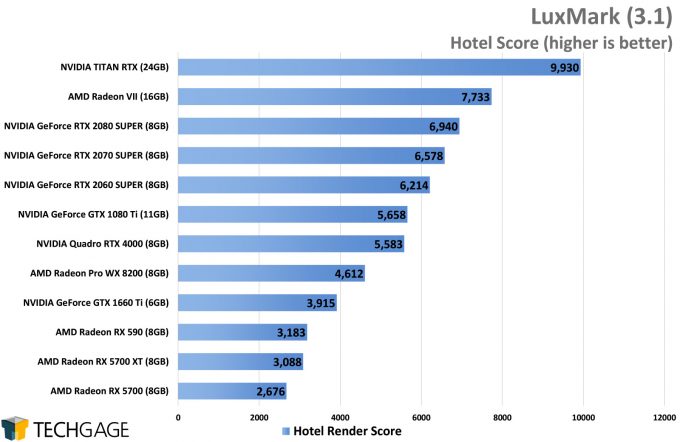- Qualcomm Launches Snapdragon 4 Gen 2 Mobile Platform
- AMD Launches Ryzen PRO 7000 Series Mobile & Desktop Platform
- Intel Launches Sleek Single-Slot Arc Pro A60 Workstation Graphics Card
- NVIDIA Announces Latest Ada Lovelace Additions: GeForce RTX 4060 Ti & RTX 4060
- Maxon Redshift With AMD Radeon GPU Rendering Support Now Available
Workstation Battle: AMD Radeon Navi vs. NVIDIA GeForce SUPER

We’ve taken a look at AMD’s latest Radeons and NVIDIA’s latest GeForces in gaming, so it’s time to turn our attention to creators. We’re pitting the RX 5700 series against NVIDIA’s RTX SUPER, with a spattering of other models added in for a fuller look at what the proviz performance picture looks like today.
Page 2 – Rendering: Blender & LuxMark
Blender
In March, we took a deep-dive look at Blender 2.80 beta performance, and now that the 2.80 final has been released (as of last week), we can compare how things have changed since then. Ultimately, performance has in fact improved a bit over the past few months, at least for GPU rendering. All of the same projects rendered seconds quicker with the 2.80 final vs. the older beta build, which is great to see.
Interestingly, the changes seemed to give the Radeon VII a sweet boost in the Classroom test. It once came behind a few NVIDIA cards, but the tides have changed. In the BMW render, the TITAN RTX manages to hold onto its top spot. At the really high-end, some odd-ish results can be seen, like the 2070S outpacing the 2080S, albeit by a single second. At this point in time, the BMW project isn’t exactly representative of current Blender work, but it somehow sees massive improvement on the TITAN RTX.
When looking at Navi’s Classroom results, it almost feels like AMD performance has been given some real polish. The $400 RX 5700 XT places well ahead of the RTX 2060 SUPER in that test, but oddly, the roles completely reverse in the BMW test. With the heavily GPU-focused Eevee renderer, NVIDIA’s Turing seems to bring about some massive performance benefits, with all of the RTX cards leading the pack. The Radeon VII’s strength in the Cycles renders didn’t carry over to Eevee too well, with it sitting close to the bottom.
For those interested in Blender viewport performance, you can check out the respective performance on page 5. For CPU performance, our recent Ryzen 3000-series look should do the trick.
AMD Radeon ProRender
Please note that we’d ordinarily have Radeon ProRender performance here, but the most current plugin version (even as of the time of writing) for 3ds Max (2.5) does not agree with our tested projects. Our issues have been similar for both CPU and GPU rendering, where a few iterations would execute without issue, but at some point, the render process seems to break, and no further rendering is taking place – despite the pass numbers continuing to iterate.
We’ve been in contact with AMD regarding this issue, and we’re hoping to conquer it soon. AMD released a number of ProRender updates at SIGGRAPH, with new plugin versions having hit Blender and Maya. Once the new version for 3ds Max drops, we’ll give it a test. If we still run into issues, we’ll work to procure more current ProRender projects that will cooperate with the current plugin better.
If you are a ProRender user, and are interested in contributing a project for use in our benchmarking, please leave a comment!
LuxMark
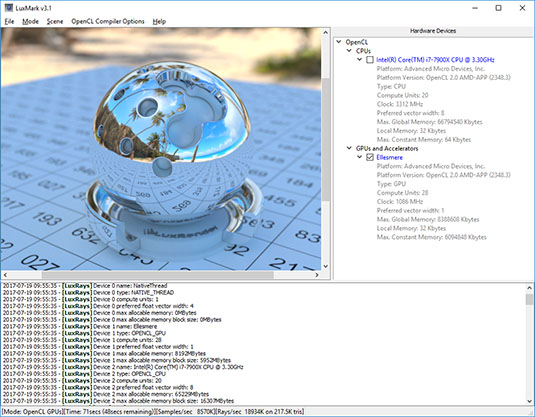
A benchmark like LuxMark proves that we can’t just run a single test and feel confident in our results, because different renders behave differently on different hardware. In the LuxBall test, the Radeon VII dominates, which is something we’ve seen ever since the card’s existed. AMD even talked about this specific result during its CES keynote, but the more complex Hotel scene was left alone – and we can see why. The VII takes out the TITAN RTX in LuxBall, but the roles reverse in Hotel.
The Navi cards perform fine in LuxBall as well, but for some reason sit at the bottom of the Hotel render chart – even behind the obviously much slower-and-older Polaris-based RX 590. We’d wager driver optimizations could improve this in time.
All-around, NVIDIA’s SUPER cards perform very well here, while AMD is clearly hit-or-miss.
Support our efforts! With ad revenue at an all-time low for written websites, we're relying more than ever on reader support to help us continue putting so much effort into this type of content. You can support us by becoming a Patron, or by using our Amazon shopping affiliate links listed through our articles. Thanks for your support!




